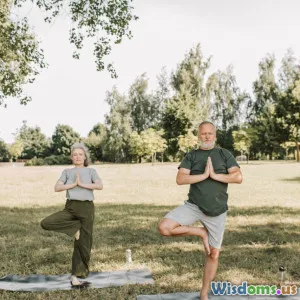
Mastering Yoga Sutras To Empower Your Soul Journey
14 min read Unlock the wisdom of Yoga Sutras to deepen your spiritual practice and empower your soul's journey towards inner peace and self-discovery. (0 Reviews)
Mastering Yoga Sutras To Empower Your Soul Journey
Yoga, in the modern world, often conjures images of twisting physical postures and serene meditation halls. Yet, beneath these physical practices lies an ancient wisdom text that endlessly enriches those who seek a deeper self-realization—the Yoga Sutras of Patanjali. These concise aphorisms, written over two millennia ago, remain an evergreen guide for personal empowerment and soul transformation. Whether you're a spiritual seeker, an avid yogi, or a curious beginner, mastering the teachings of the Yoga Sutras can indelibly empower your soul journey.
Discovering the Yoga Sutras: Foundations of Soul Empowerment

The Yoga Sutras, composed by the sage Patanjali sometime between 200 BCE and 400 CE, are just 196 terse, powerful statements (sutras) that systematically lay out the philosophy and psychology of yoga. Rather than being a physical manual, the Yoga Sutras serve as a blueprint for navigating inner consciousness and the obstacles to the soul's freedom.
Key Pillars of the Sutras:
- Clarity: Each sutra encapsulates a single, potent insight, making them accessible and memorable.
- Universality: Despite their historical roots, the issues Patanjali addresses—anxiety, desire, distraction—are universally human.
- Systematic Approach: The Sutras present an eight-limbed path (Ashtanga Yoga), progressing from ethics to ultimate union, and providing a structured means for any sincere practitioner to pursue kaivalya (liberation).
Modern yogis such as B.K.S. Iyengar and T.K.V. Desikachar adopt these Sutras as the authoritative text to ground postural and meditative practices with a holistic, soul-driven focus. This integration, when internalized, transforms yoga from a physical exercise into an empowering journey toward self-realization.
Example – Sutra I.2: “Yoga citta vrtti nirodhah”
This is perhaps the most quoted sutra, succinctly defining yoga as "the cessation of the fluctuations of the mind." By learning not only to recite but to practice this teaching daily—by observing thoughts without judgement—you plant the seeds for inner empowerment and peace.
Meditation & Awareness: Practical Applications for Daily Transformation

Mastering the Yoga Sutras is not about theoretical study alone. The power of the Sutras lies in practical application—especially through meditation, self-reflection, and conscious living.
How-To Practice Mindfulness with the Sutras
-
Daily Reflection: Set aside 10-20 minutes each day. Pick a sutra. Recite it slowly, consider its meaning, and observe how it mirrors your current life.
-
Journaling: Write about your experiences or obstacles associated with the selected sutra—such as impatience, restlessness, or joy.
-
Active Awareness: Throughout your day, bring your awareness back to the teaching. For example, if working with Sutra I.33 (on cultivating joy, compassion, and equanimity), actively practice kindness and non-reactivity in every interaction.
Transformative Example: Sutra II.16 “Heyam Dukham Anagatam”
This sutra teaches: "Future suffering can—and should—be avoided." Understanding this shifts your outlook from fatalistic resignation to empowered action. If you're facing anxiety over future events, this wisdom inspires proactive choices: prioritizing mental management over ruminating on what could go wrong.
Countless practitioners have re-centered anxious minds and broken cycles of suffering using this daily observance, reporting improvements in emotional regulation and resilience after only a few weeks of dedicated practice.
The Eight Limbs of Yoga: Step-by-Step Guide for Empowered Living

At the heart of the Yoga Sutras rests a practical framework: the Ashtanga Yoga system, or Eight Limbs of Yoga. Mastery of these limbs leads to spiritual empowerment, guiding you from outward ethics to deep meditative absorption and harmony. Let's break down each limb with actionable advice.
1. Yama – Ethical Self-Restraint
Ahimsa (non-violence), Satya (truthfulness), Asteya (non-stealing), Brahmacharya (moderation), and Aparigraha (non-possessiveness).
- Tip: Pick one yama per week. Journal examples of where that quality is challenged or supported in your interactions.
- Example: If working on Ahimsa, observe moments of harsh self-talk and gently shift to self-compassion.
2. Niyama – Self-Discipline and Observances
Saucha (purity), Santosha (contentment), Tapas (discipline), Svadhyaya (self-study), Ishvara Pranidhana (surrender to higher wisdom).
- Actionable Advice: Integrate Svadhyaya by reading spiritual texts or reflecting on your responses to day-to-day events.
3. Asana – Posture
The physical poses many associate with modern yoga originate as a foundation for comfort in meditation.
- Tip: Instead of elaborate routines, prioritize steady, comfortable sitting. Even basic flexibility work (like gentle forward bends) supports deeper meditation.
4. Pranayama – Breath Control
Harnessing breath is essential for regulating energy and emotions.
- How-To: Practice alternate nostril breathing for 5 minutes daily to calm the mind before meditation sessions.
5. Pratyahara – Turning Inward
Detachment from sensory overwhelm trains your attention on your inner world.
- Advice: Begin with tech-free mornings for a week. Notice changes in clarity and mood when sensory interruptions decrease.
- Example: Yoga practitioners at retreats often report heightened creativity and improved decision-making after a few days of sensory detox.
6. Dharana – Focused Concentration
Concentration builds willpower and insight.
- Exercise: Use a candle flame or mantra. Each time your mind drifts, kindly redirect attention.
- Tip: Increase duration by a minute each week.
7. Dhyana – Meditation
Sustained, unbroken attention ushers in stillness and natural joy.
- Practical Insight: Daily meditation, even for 10 minutes, has been shown in peer-reviewed neuroscientific studies (e.g., Harvard, 2011) to thicken areas of the brain associated with emotion regulation and perspective.
8. Samadhi – Soul Liberation
The culmination: dissolving the separations between self and universe.
Samadhi is not an esoteric concept reserved for hermits; many today taste its peace through brief glimpses—a sense of timelessness during mindful practice, or pure connectedness in everyday moments.
- Example: Long-distance runners, artists in flow, and meditators alike report experiences of samadhi’s non-dual awareness.
Integrating these steps transforms daily existence into a soul-empowering quest—one deliberately crafted breath and action at a time.
Overcoming Obstacles on the Yoga Path

Ancient wisdom acknowledges that transformation is neither linear nor effortless. The Yoga Sutras list tangible obstacles—such as disease, doubt, lack of focus, and lethargy—that every practitioner encounters (Sutra I.30). Awareness is the first step to mastery.
Pro Tips to Navigate Common Hurdles
- Discouragement: Accept initial impatience as natural. Rather than self-blame, use gentle discipline. World-renowned yoga teachers (e.g., Sharon Gannon of Jivamukti Yoga) recommend celebrating small milestones instead of fixating on distant perfection.
- Inconsistency: Anchor new habits to established routines (e.g., meditating right after morning teeth-brushing).
- Doubt: Pair study of supportive commentaries (such as those by Swami Satchidananda) with discussions in spiritual communities or with online sanghas.
- Restlessness: Modern distractions abound—acknowledge them without condemnation, and return to breath as your anchor.
- Physical Discomfort: Adapt postures in consultation with experts. Patanjali emphasizes steadiness, not acrobatics.
Real-World Transformation
Emma, a 35-year-old teacher, struggled with stress-induced insomnia and self-judgment. Applying Sutra I.12 (the power of persistent practice and renunciation), she committed to 15 minutes of daily breath-meditation and gradually found clarity and acceptance within. Over several months, her sleep improved and decision-making sharpened—not due to external change, but through inner empowerment via the Sutras’ principles.
Integrating Ancient Wisdom Into Modern Life

The beauty of the Yoga Sutras lies in their adaptability, regardless of background or present circumstance. While yogic wisdom arose in ancient forests and hermitages, it pulses with relevance for contemporary challenges: chronic stress, endless busyness, and digital overload.
Practical Integration Strategies
- 5-Minute Micro-Practices: Rather than waiting for the 'perfect' 60-minute class, sprinkle brief Sutra-inspired rituals—mindful breathing, affirmation of ahimsa, non-attachment check-ins—through your day.
- Tech-Assisted Mindfulness: Use meditation and yoga apps that offer daily Sutra explanations (such as Insight Timer or YogaGlo) to anchor practice and inspire reflection.
- Soulful Community: Join discussions, either locally or virtually. Many yoga studios and online forums (e.g., global mindfulness communities) offer weekly Sutra circles, fostering a sense of accountability and empowerment.
- Ethical Habits at Work: Integrate yama and niyama in daily business interactions by prioritizing honesty, cooperation, and personal growth—traits shown to boost job satisfaction (Gallup 2022 Workplace Survey).
Case Study: Sutra-Inspired Corporate Change
In 2021, a Fortune 500 tech company introduced weekly Yoga Sutra workshops for employees, blending ethical leadership training with on-site meditation. Result? After six months, reported stress levels dropped by 19%; creative solutions and team cohesion rose noticeably, as detailed in HR white papers.
Our rapidly changing world prompts us to return, again and again, to these enduring touchstones—that true empowerment comes not from fleeting achievement but from sustained inner work.
Wisdom Beyond Words: Continuing Your Yoga Sutra Journey

Ultimately, true mastery of the Yoga Sutras isn’t about memorization, but about living their truths. Each lesson excavates hidden strength, resilience, and peace from the depths of the soul and equips you for every twist in your personal journey.
Lifelong Learning Tips
- Find a Trusted Guide: Seek out reputable translations or teachings from respected teachers—online, in books, or local yoga communities. A few enduring favorites: Swami Satchidananda’s The Yoga Sutras of Patanjali, Chip Hartranft’s accessible commentary, and the classes offered by the Himalayan Institute.
- Embody the Teachings: Let practice inform understanding. The Sutras are a lived experience, not just a literary one—test, adapt, and gently persist.
- Reflect & Adapt: Keep a Sutra diary to record discoveries and changing interpretations. Over months and years, you’ll notice profound shifts in your inner world.
- Share the Wisdom: Discuss insights with friends, students, or sangha. Service and sharing activate the energy of the Sutras, fueling your own transformation.
Empowerment, as the Yoga Sutras teach, blooms with each mindful step—through patience, honest reflection, and the courage to look within. As you deepen this ancient dialogue, you carve a soul journey luminous with clarity, resilience, and profound joy.
Rate the Post
User Reviews
Popular Posts




















